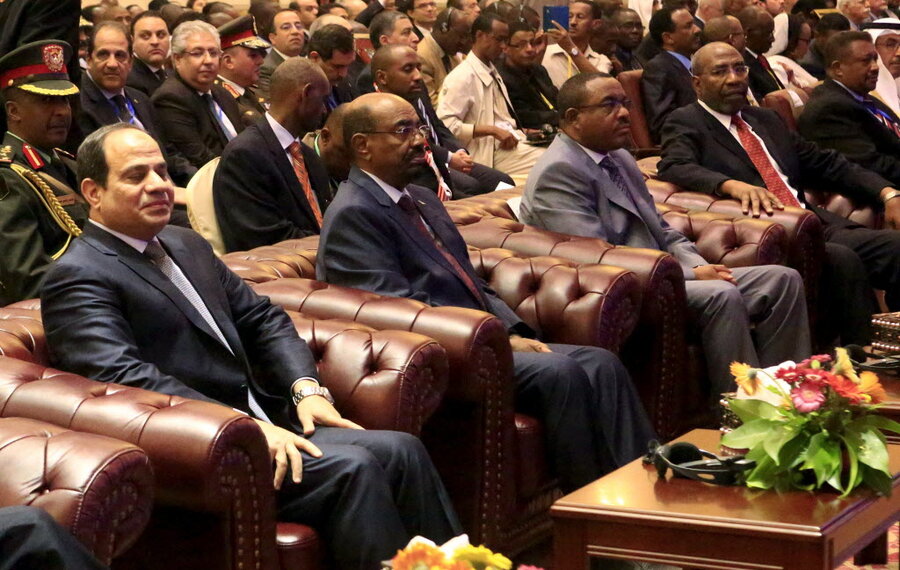Egypt signs Nile dam deal with Ethiopia after years of dispute. What changed?
Loading...
| Addis Ababa, Ethiopia
A new agreement between Egypt, Ethiopia and Sudan on a controversial Ethiopian hydroelectric dam is a diplomatic breakthrough that supporters say could fuel economic development in the Nile basin.
Egyptian President Abdel Fattah al-Sisi called it “a new chapter in the history of Egyptian-Ethiopian relations” and opened the door to further negotiations on the $4.8 billion Great Ethiopian Renaissance Dam.
Ethiopia says the dam will ultimately provide 6,000 megawatts of power in a country where it's desperately needed. The UN's International Energy Agency estimates that 70 million Ethiopians don't have access to electricity - the most on the continent, and East Africa is one of the most energy-impoverished spots on the globe.
For years Egypt had stood in the way of the effort, terrified it could reduce the annual Nile floods that the country's farms and cities rely upon, and treating upstream dam building as a national security threat. The old stance was hardly surprising; Herodotus' observation that Egypt is "the gift of the Nile" is as true today as it was 2,500 years ago.
Ethiopia's decision to start construction in 2011 - amid the turmoil that saw Hosni Mubarak ousted from power - was seen as an act of aggression, and further deteriorated discussions. In 2013, Egyptian lawmakers even discussed military action as a last resort if diplomatic efforts failed to convince Ethiopia to stop the project.
But President Sisi's position, a radical departure from decades of Egyptian policy, apparently signals a greater degree of trust and potential for cooperation.
Though the new document does not create unconditional support for the dam and the technical aspects have not changed, it provides a guideline for negotiations between the three countries. After the signing, President Sisi said his country had sought assurances that the dam will not significantly cut the river's flow to Egypt's growing population.
"You will develop and grow and I am with you, but beware that in Egypt the people live only on the water that comes from this river,'' he said.
Egypt has viewed the dam as a security threat that could reduce its annual water share as the dam’s 63 billion cubic meter reservoir is filled. The dam and the power plant are expected to be operational by 2017. According to Egypt’s current Foreign Minister Hisham Qandil, the old treaty water amount –set under British colonial rule and that gave Egypt the largest share of the Nile --was incrementally less able to satisfy Egypt’s needs. The country, he said, had recently entered “hydraulic poverty.”
Experts believe Egypt likely softened its position after reaching a crossroads where it had to choose between joining its riparian neighbors, or casting itself as a lone aggressor. Most of the Nile countries had signed into a 2010 Nile-based treaty with Ethiopia called the Entebbe Agreement that gave them greater Nile bargaining rights.
"Now Egypt is alone. What can they do?” says Dr. Shafiqul Islam, director of the Water Diplomacy Program at Tufts University, adding that Ethiopia has promised not to affect water flow to Egypt. “Does Egypt believe it? Perhaps not. But they do not have much option.”
Therese Sjömander Magnusson, manager of the UNDP Shared Waters Partnership program, also adds that the potential benefits like development, regional collaboration and energy trading likely forced Egypt to drastically change its stance.
“Egypt found that by allowing this dam they can purchase cheaper hydropower [from Ethiopia],” Mr. Islam adds.
Egypt has benefitted from a majority share of the Nile’s waters for most of the past century, due to treaties it signed under English colonial rule. Even though more than two-thirds of the Blue Nile tributary originates in Ethiopia, these colonial-era treaties give Egypt and Sudan the majority of the Nile's water.
Islam says that the filling schedule is the only operational aspect of the dam that could play out as a point of contention between Egypt and Ethiopia moving forward. As long as Ethiopia fills the reservoir gradually - pooling some water at the dam site while still letting out a consistent stream - he argues that the downstream impact will be minimum.





